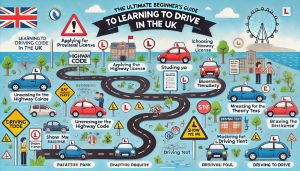 The Ultimate Beginner’s Guide to Learning to Drive in the UK
The Ultimate Beginner’s Guide to Learning to Drive in the UK
Learning to drive is a major milestone that opens the door to independence, freedom, and new opportunities. But if you’re just starting out, the process can feel confusing. From licences and lessons to tests and road rules, there’s a lot to take in. That’s why we’ve put together this ultimate beginner’s guide to learning to drive in the UK.
Step 1: Apply for Your Provisional Licence
Before you can start learning, you need a provisional driving licence. You can apply online through the DVLA once you’re 15 years and 9 months old, though you’ll need to wait until you’re 17 to drive a car. Make sure you keep your licence safe—you’ll need it for lessons, theory tests, and the practical test.
Step 2: Learn the Basics of the Highway Code
The Highway Code is the foundation of driving in the UK. It covers road signs, speed limits, lane markings, and rules for different types of road users. Reading it early will make your first lessons less overwhelming.
Step 3: Choose the Right Driving Instructor
Finding a good instructor is crucial. Look for a DVSA-approved driving instructor (ADI), ideally with strong reviews and a teaching style that suits you. Don’t hesitate to try a couple of instructors before settling on the right fit.
Step 4: Book Regular Driving Lessons
Consistency is key. Most learners need around 45 hours of lessons plus 20 hours of practice before taking their test. Booking 1–2 lessons per week helps you retain skills and build confidence steadily.
Step 5: Practise Outside of Lessons
If you have access to a car and a supervising driver (21+ with three years’ driving experience), practise in quiet areas outside of lessons. This extra experience will help you progress faster and feel more comfortable behind the wheel.
Step 6: Prepare for the Theory Test
The theory test has two parts:
-
Multiple-choice questions based on the Highway Code.
-
Hazard perception, where you spot developing hazards in video clips.
Use apps, online practice tests, and revision books to prepare. Passing your theory is a must before you can book your practical driving test.
Step 7: Gain Experience in Different Conditions
Don’t limit yourself to driving in good weather or quiet roads. Try lessons or practice during rain, night-time, and busy traffic. The more varied your experience, the better prepared you’ll be for real-world driving.
Step 8: Learn Key Manoeuvres
Your instructor will teach you manoeuvres that often appear in the test, such as:
-
Parallel parking
-
Bay parking
-
Pulling up on the right and reversing
-
Emergency stop
Practise these until you feel confident, as they’re a vital part of safe driving.
Step 9: Book and Take Your Practical Test
When your instructor feels you’re ready, book your practical driving test. On the day, you’ll be assessed on your ability to drive safely, follow road rules, and demonstrate manoeuvres. Stay calm, focus on the road, and remember that minor mistakes don’t always mean failure.
Step 10: Keep Learning After You Pass
Passing your test is just the start. Many new drivers choose to take a Pass Plus course to build skills in motorway driving, night driving, and adverse weather. The more you practise, the safer and more confident you’ll become.
